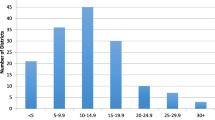Abstract
Trachoma continues to be a leading cause of blindness largely confined to developing countries. Trachoma control programs have primarily been oriented to drug therapy, an approach which may be successful if it is community-based. However, the costs to ensure long-term success are substantial. Community-based health education approaches to reduce risk factors currently provide the most promising approach for long-term trachoma control.
Similar content being viewed by others
References
Assaad FA, Maxwell-Lyons F, Sundaresan T. Use of local variations in trachoma endemicity in Taiwan to elucidate some of the clinical and epidemiological aspects of the disease. Bull WHO 1968; 39: 567–86.
Clemens JD, Stanton BF. An educational intervention for altering water-sanitation behaviors to reduce childhood diarrhea in urban Bangladesh. I. Application of the casecontrol method for development of an intervention. Am J Epidemiol 1987; 125: 284–301.
Darougar S, Jones BR, Viswalingam N, Poirier RH, Allami J, Houshmand A, Farahmandian MA, Gibson JA. Family-based suppressive intermittent therapy of hyperendemic trachoma with topical oxytetracycline or oral doxycycline. Br J Ophthalmol 1980; 64: 291–95.
Darougar S, Jones BR, Viswallingam, Allami J, Minassian D, Farahmandian MA, Houshmand D. Topical therapy of hyperendemic trachoma with rifampicin, oxytetracycline, or spiramycin eye ointments. Br J Ophthalmol 1980; 64: 37–42.
Dawson C, Hanna L, Rodman W, Coleman V, Brianes O, Jarvetz E. Controlled trials with trisultapyrimidines in the treatment of chronic trachoma. J Infect Dis 1969; 119: 581–90.
Dawson C, Schachter J. Strategies for treatment and control of blinding trachoma: cost-effectiveness of topical or systemic antibiotics. Rev Infect Dis 1985; 7: 768–73.
Dawson C, Elashoff R, Hanna L, Hoshiwara I, Ostler H. The evaluation of a controlled trachoma therapy trial with oral tetracycline. In: Nichols RL, ed. Trachoma and Related Disorders. Amsterdam: Excerpta Medica, 1971.
Dawson CR, Jones BR, Tarizzo ML. Guide to trachoma control. Geneva: World Health Organization, 1981: 38–47.
Dawson CR, Daghfous T, Hoshiwara I, Ramdhane K, Kamoun M, Yoneda C, Schachter J. Trachoma therapy with topical tetracycline and oral erythromycin: a comparative trial. Bull WHO 1982; 60: 347–55.
Foote DR, Hughes-Lind L, Kendall C, Martorell R, McDivitt JA, Snyder L, Spain PL, Stone SM, Storey JD. The mass media and health practices evaluations in Honduras and the The Gambia: summary report of the major findings. Report: Communication for Child Survival, 1985: 1–75.
Goldsmith AA. Operations research issues: community organization. Chevy Chase, Maryland: PRICOR Center for Human Services, 1985.
Grayston JT, Gale JL, Yeh L-J, Yang C-Y. Pathogenesis and immunology of trachoma. Trans Assoc Am Physicians 1972; 85: 203–11.
Jones BR. The prevention of blindness from trachoma. Trans Ophthalmol Soc UK 1975; 95: 16–33.
Keyvan-Larijani E, Tielsch JM, Katz J, Johnson G, Schwab L, Tizazu T, Chirambo M, Taylor HR. Epidemiology of trachoma in Lower Shire Valley, Malawi. Invest Ophthalmol Vis Sci 1986; 27 (Suppl): 98.
Mann I. Correlation of race and way of life in Australia and the Territory of Papua and New Guinea with incidence and severity of clinical trachoma. Am J Ophthalmol 1967; 63: 1302–09.
Marshall CL. The relationship between trachoma and piped water in a developing area. Arch Environ Health 1958; 17: 215–20.
Nichols RL, Bobb AA, Haddad NA, McComb DE. Immunofluorescence studies of the microbiological epidemiology of trachoma in Saudi Arabia. Am J Ophthalmol 1967; 63: 1371–1408.
Reinhards J. Trachoma control in the European regions. WHO Chron 1967; 21: 57–61.
Report of the National Trachoma and Eye Health Program. Sydney: The Royal Australian College of Ophthalmologists, 1980.
Schachter J. Overview of Chlamydia trachomatis infection and the requirements for a vaccine. Rev Infect Dis 1985; 7: 713–16.
Schaefer M, Reynolds J. Operations research issues: community health workers, Chevy Chase, Maryland: PRICOR Center for Human Services, 1985.
Sutter EE, Ballard RC. Community participation in the control of trachoma in Gazankulu. Soc Sci Med 1983; 17: 1813–17.
Taylor HR, Sommer A. Risk-factor studies as an epidemiologic tool. Rev Infect Dis 1985 7: 765–67.
Taylor HR, Millan-Velasco F, Sommer A. The ecology of trachoma: an epidemiological study of trachoma in Southern Mexico. Bull WHO 1985; 63: 559–67.
Thygeson P. Epidemiologic observations on trachoma in the United States. Invest Ophthalmol 1963; 2: 482–89.
Thylefors B. Development of a trachoma control program and the involvement of natural resources. Rev Infect Dis 1985; 7: 774–76.
UNICEF. Community Participation: current issues and lesson learned. Assignment Children 59, 1983.
UNICEF-WHO Joint Committee on Health Policy. Community involvement in primary health care: a study of the process of community motivation and continued participation. WHO Report JC21/UNICEF-WHO/77.2, 1977.
Unpublished proceedings. Research priorities for the control of trachoma workshop. June 1987. Woodshole, Massachusetts: The Edna McConnell Clark Foundation, 1987.
World Health Organization. Expert committee on trachoma, third report. WHO Technical Report Series, 234. Geneva: World Health Organization, 1962.
Author information
Authors and Affiliations
Rights and permissions
About this article
Cite this article
West, S., Taylor, H.R. Community-based intervention programs for trachoma control. Int Ophthalmol 12, 19–23 (1988). https://doi.org/10.1007/BF00133776
Issue Date:
DOI: https://doi.org/10.1007/BF00133776




